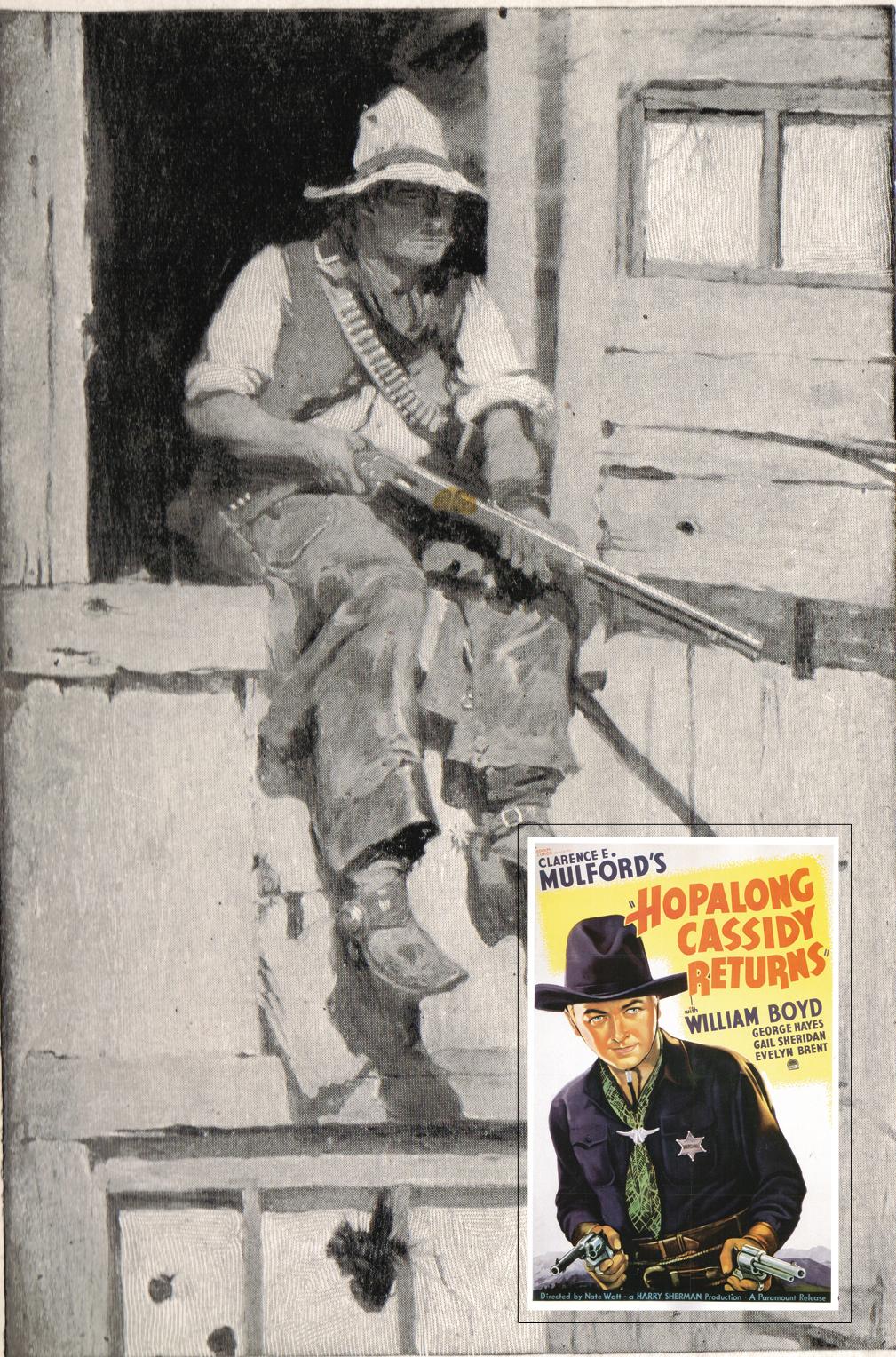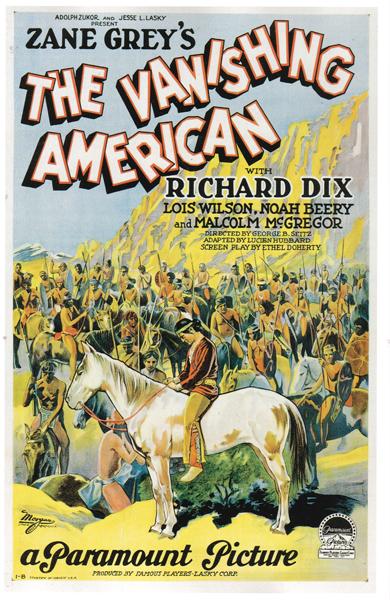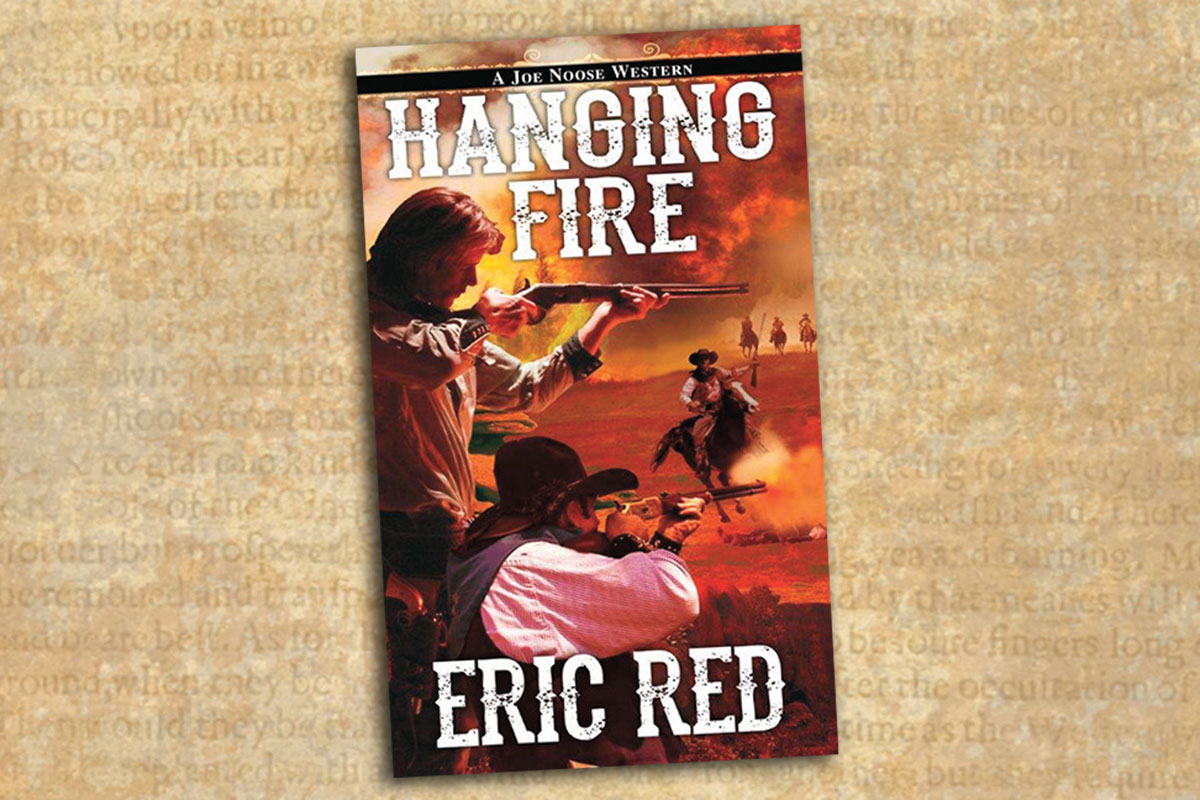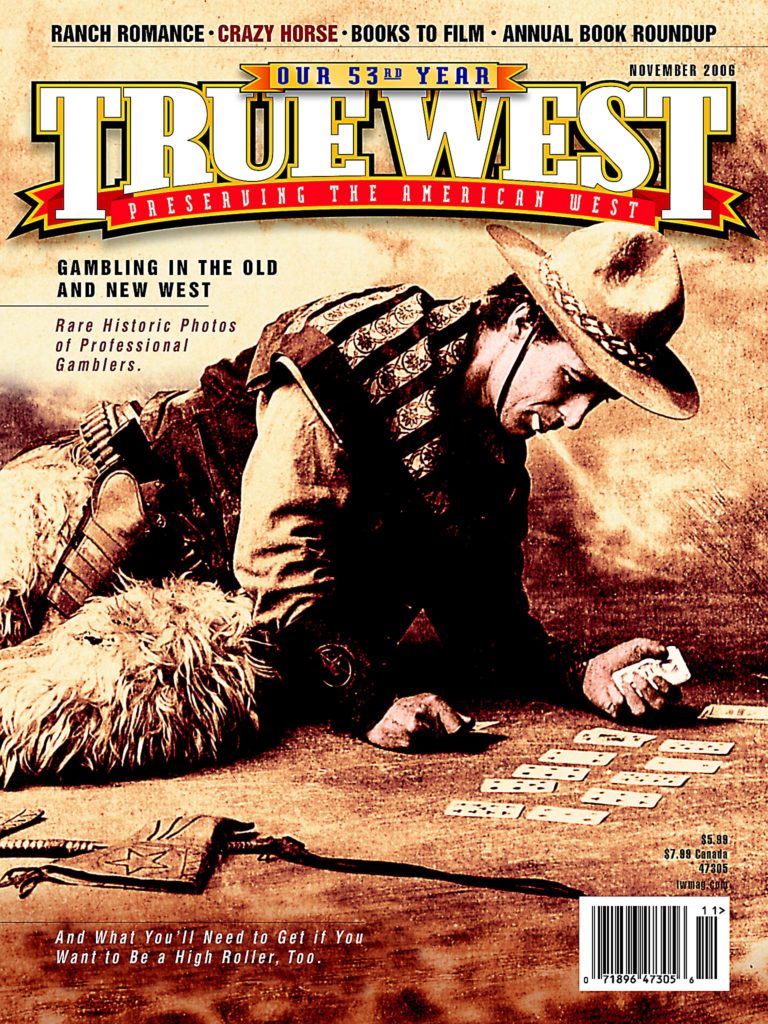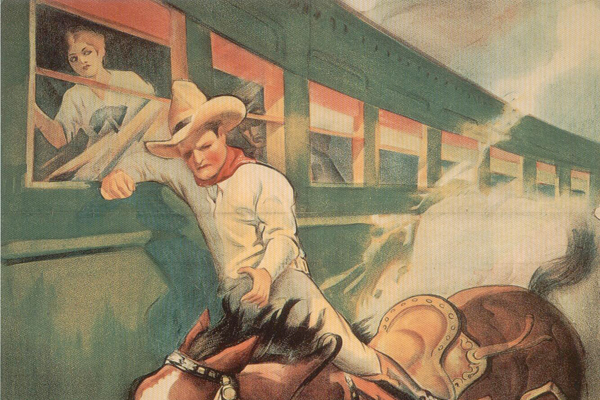 The Great Train Robbery (1903) started it all. Not only was it the first narrative film ever made, but it was a Western and one based on an 1896 story by Scott Marble.
The Great Train Robbery (1903) started it all. Not only was it the first narrative film ever made, but it was a Western and one based on an 1896 story by Scott Marble.
The roughly 10-minute action picture was so well-received by audiences that the movie established films as a commercially-viable medium. Early producers sought out their own Scott Marble and turned to pulp fiction magazines for writers and stories. The silents of the 1920s adapted Zane Grey short stories as well as those by Peter B Kyne, humorist O Henry, Edna Ferber, Johnston McCulley, Clarence E. Mulford, W.C. Tuttle, Owen Wister, Harold Bell Wright, James Oliver Curwood, Jack London and Rex Beach. Serials and films of the later decades drew on material by Louis L’Amour, Larry McMurtry, Alan LeMay, Lauran Paine and Jack Schaefer.
As with filmmaking, good source material does not necessarily make a good film. Nor do good films mean good source material. Writers may create fiction with an eye to the visual, but when the final product is onscreen, was the adaptation accurate?
When we think of great literary achievements brought to today’s film, the most successful modern author is Larry McMurtry. With Lonesome Dove, Streets of Laredo, Buffalo Girls, Dead Man’s Walk, Johnson County War, Texasville, the upcoming Comanche Moon and Montana (among others) to his writing credit, McMurtry is a writer … who happens to have written Westerns. His novels bristle with life. His characters leap off the page and live within the confines of the covers and grasp our imagination by the proverbial horns. If we consider the Lonesome Dove franchise, it is our modern-day Sacketts, and as such, has been tapped by Hollywood and cable networks for very successful films and TV.
As much success as McMurtry has had in his career, he was not the first to adapt to filmmaking.
Paul Leicester Ford
Ford is most known for his George Washington biography and his 10-volume The Writings of Thomas Jefferson. He died in 1902, but his 1897 book, The Great K&A Train Robbery, seemed a perfect fit for a Tom Mix film, released with the same title in 1926. Mix plays a detective who dons a mask to infiltrate the outlaw gang behind the robberies. The silent screen actor said that a young John Wayne worked as a prop boy on this film.
Zane Grey
Zane Grey was one of the most prolific (and influential) writers of the early 1900s. His most popular novel, Riders of the Purple Sage, is about a Mormon-born spinster who inherits a ranch and finds herself persecuted by her Mormon fellows when she refuses to marry a polygamous elder. That tale found filmgoers heading to theaters three times; in 1918, 1931 and 1941, stars William Farnum, George O’Brien and George Montgomery brought Grey heroes to life. Other successful book-to-film translations from Grey include King of the Royal Mounted (1940), The Border Legion (1918, 1924, 1930, 1940), Lone Star Ranger (1942) and Western Union (1941) with Robert Young.
Zorro and Hopalong Cassidy
Two early “heroes” of the 20th century, Zorro and Hopalong Cassidy, quickly made the transition to film. But while one hero remained virtually untouched, the other was transformed into a shadow of his former self.
Johnston McCulley’s immortal creation premiered in 1919 in Argosy magazine in the serial “The Curse of Capistrano.” Not long after, Douglas Fairbanks, Sr., portrayed De La Vega in the 1920 production, The Mark of Zorro, and made movie history. Thirty-five films later, Antonio Banderas lit up the screen in The Legend and Mask of Zorro in 2005 and 1998. What made Zorro so successful? Read any one of the McCulley stories and discover the balance between hero and coward.
The Hopalong Cassidy of Clarence E. Mulford was not so nice. Where the 1950s Hoppy drank milk and taught kindness to children around the world, the real Cassidy drank, swore, gambled and, yes, even killed. William Boyd portrayed Hoppy in 66 films (1935-48) and on the much beloved TV show. The first novel, Bar-20, not only has riveting prose, but it also features art by N.C. Wyeth and F.E. Schoonover that captures the spirit of the man who would become a major literary figure.
Edna Ferber
The first Western to win a Best Picture Oscar (in 1931), Cimarron was based on the novel of the same name by Edna Ferber. Richard Dix starred as Yancey Cravat, land owner, lawyer, publisher and entrepreneur in the boomtown of Osage, Oklahoma. The title comes from the Cimarron Territory (“No Man’s Land,” inhabited by Indians), of which Oklahoma was one until the government opened up the territory for settlement in 1889. One strong element in both the film and the book is the wanderlust of Yancey, who leaves for years at a time to find his fortune in war and gold rushes. The movie was remade in 1960, directed by Anthony Mann, with Glenn Ford as Yancey, but the 1931 version is the better of the two.
B. Traven
Traven wrote primarily in German and was a reclusive author who preferred his anonymity. His 1934 novel, The Treasure of the Sierra Madre (Der Schatz der Sierra Madre), explored gold lust and its effect upon obsessed partners. The 1948 film produced by John Huston (starring Humphrey Bogart and Walter Huston) stands as a high mark in film history. It’s also the movie with the oft-repeated misquote: “Badges? We don’t need no stinking badges!” The bandit leader actually says, “We don’t need no badges. I don’t have to show you any stinking badges.”
Ernest Haycox
John Ford was no stranger to pulp fiction for his films. His 1939 classic, Stagecoach, starring John Wayne and Claire Trevor, was based on the Ernest Haycox short story “Stage to Lordsburg” that first appeared in 1937 . Other Haycox yarns, Trouble Shooter, Sundown Jim and Man in the Saddle, also inspired Westerns during Hollywood’s Golden age. (Trouble Shooter was the basis for the Cecil B. DeMille flick, Union Pacific, starring Barbara Stanwyck and Joel McCrea.)
Max Brand
The year 1939 was a good one for films. Destry Rides Again, starring Jimmy Stewart and Marlene Dietrich, was based on the novel of the same name by Max Brand (pen name of Frederick Faust). Dietrich, appropriately, picked a Western as her first film after becoming an American citizen. She plays a sultry saloon gal, while Stewart plays the atypical deputy who doesn’t believe law and order is served by guns (although, he isn’t anti-violence). The film was first released in 1932, starring Tom Mix and later in 1954 with Audie Murphy.
Walter Van Tilburg Clark
The celebrated novelist, Walter Van Tilburg Clark, published his first novel, The Ox-Bow Incident, in 1940 to much critical acclaim. Telling the unconventional story of a murder and cattle robbery, a posse gone wrong and misdirected mob justice, the 1943 film starring Henry Fonda is regarded as a classic. (In October 2006, TW reviewed Track of the Cat, another movie based on a Clark novel of the same name.)
Owen Wister
The Virginian by Owen Wister is largely regarded as the quintessential Western novel. Wister tells the story of The Virginian, a ranch foreman who is forced to hang his best friend over cattle rustling charges. This novel has it all, strong heroes, grand themes and the law of the gun. No wonder it made such a great film in 1946 with Joel McCrea. The nine-year NBC series, starring James Drury, was not so bad either! Neither was TNT’s movie remake in 2000, which paired up Bill Pullman and Diane Lane.
Louis L’Amour
Louis L’Amour hit paydirt with many of his novels. Regarded as “America’s storyteller,” L’Amour had an uncanny knack to translate his passion for his characters and story to the page. Hondo was his first success in 1953. Based on his story, “The Gift of Cochise,” the film starred John Wayne and Geraldine Page. L’Amour’s multi-generation saga, The Sacketts, hit TV screens in 1979. Tom Selleck has appeared in TNT’s The Shadow Riders (1982) and Crossfire Trail (2001), while other TV movies based on L’Amour’s works include Conagher (1991), Shaughnessy (1996) and the film Apache Territory (1958). If I were a betting man, I’d lay money on a L’Amour tale any day, pick your medium.
Alan LeMay
Alan LeMay had an amazing career. As a successful Hollywood screenwriter, he wrote 20-plus films. As a novelist, he wrote The Searchers (1956) and High Lonesome (1950). John Ford and company trans-formed The Searchers into a classic film; it stars Wayne as Ethan, who embarks on a five-year quest to find his niece, Debbie (Natalie Woods), who has been kidnapped by the Comanches. Whether it was the cast (John Wayne, Harry Carey, Jr), Monument Valley, Ford’s direction or an outstanding novel, the film still stimulates conversation amongst critics today. I say “best,” how about you?
Jack Schaefer
Shane is also touted as one of the greatest Westerns ever filmed. Houghton Mifflin took Schaefer’s three-part serial, “Rider from Nowhere,” which appeared in a 1946 issue of Argosy, and published it as Shane in 1949. The novel is told from the point of view of a young boy, Bob Starrett. In the 1953 film, he’s called Joey and is played by Brandon DeWilde. Alan Ladd stars as the gun-slinging Shane who drifts into a Wyoming town and finds himself caught in a war between his new employer, Joe Starrett, and a cattle baron who wants Starrett’s land. The 1966 ABC series starred David Carradine in the title role.
Charles Portis
John Wayne has a strong connection to great films. His 1969 film, True Grit, was based on Charles Portis’ 1968 novel of the same name (a reissue is published by Overlook Press in Woodstock, New York). Sharing the same strength of character as The Virginian, Shane and John Dunbar (see next entry), Rooster Cogburn is an archetypal frontiersman that we all want to be. That is the beauty of Grit
Michael Blake & Lauran Paine
One of the most memorable book-to-film projects was Kevin Costner’s Dances With Wolves (1990). Based on the book by Michael Blake, the story of Lt. John Dunbar and his transition from soldier to Indian captured the imagination of moviegoers around the world and seven academy awards, including Best Picture, making it the first Western to garner such a win since Cimarron.
Another successful Kevin Costner project was Open Range, with Robert Duvall. The film drew moviegoers to theaters in 2003 by the herd. Full of wide open spaces, a range war waiting to happen and strong, vibrant characters, the movie stands as a “how to” of Western filmmaking. Based on the Lauran Paine novel of the same name, Open Range screamed MOVIE from the first chapter.
Many contemporary authors’ works share the same cinematic presence of Grey, L’Amour and McMurtry. Works by David Thompson, Johnny D. Boggs, Kirby Jonas, Ralph Compton and Cotton Smith are my top picks this year for novels that could make great films.
David Thompson
David Thompson, in his long running “Wilderness” series, tells the story of
Nate King and “Shakespeare” McNair, and their adventures in the Rocky Mountains in the early 1800s. Just like Dances With Wolves makes you want to be Indian, these books awaken the frontiersman in all of us with the addicting, hypnotic stories of survival in a land without remorse. The latest work, Lord Grizzly, is published by Leisure.
Kirby Jonas
Artist/writer Kirby Jonas fills his books with strong central characters and authentic settings and plots. His enthusiasm for his craft is evident and would translate well to the screen given a like minded director. Lady Winchester (published by Howling Wolf Publishing in 2000), as a movie, would fit in well with other films with strong female leads, such as McMurtry’s Buffalo Girls and The Quick and the Dead.
Johnny D. Boggs
An amazing book by Johnny D. Boggs, Dark Voyage of the Mittie Stephens (published by Leisure in 2005), would have been a shoe-in for the big screen 50 years ago. Based on a true story, Voyage demonstrates Boggs’ cinematic approach to storytelling and his compelling, natural characterization skills. There’s always room for a good riverboat adventure!
Cotton Smith
Cotton Smith is another modern writer with cinematic potential. Books like Sons of Thunder and Stands a Ranger that play on the strong Rooster Cogburn/Shane mold, grand themes, moral conflicts and courage are characteristic of his fiction. A good bet for film … Sons of Thunder (published by Leisure in 2003).
Ralph Compton
Ralph Compton is a man out of time. Published by Signet, Six Guns and Double Eagles, The Autumn of the Gun, The Killing Season and The Shadow of a Noose are only four of his many books that blend action, revenge and dogged determination in the mold of The Searchers. They’re perfect material for a film series.
Given a more fertile marketplace for Western films and TV series, these modern chroniclers of the Old West could claim their share of immortality and stand alongside the giants who have transcended fiction and made it onto the big screen.
Tim Lasiuta was born in the wrong era. His interests lie in classic literature, art, comics, books and culture. Visit LoneRangerCartoonist.com for his latest book.


